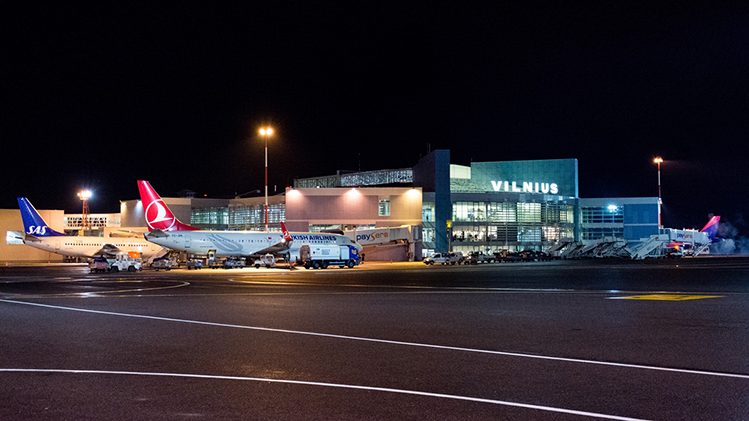Lithuanian Airports, the national airports’ network comprising Vilnius, Palanga and Kaunas airports, has been drastically affected by the COVID-19 pandemic, with no regular passenger air services performed since mid-April 2020.
“In preparation to return to normal airport operations and continue growth, Lithuanian Airports have ramped up their negotiations with air carriers for the return of essential routes,” explains Marius Gelzinis, CEO Lithuanian Airports. “That is the key target for our team for the near future, along with the adoption of additional safety measures inside the airports.”
The three international airports of Lithuania served 1.104 million passengers in Q1 2020 – 16.4% less than during the same period in 2019. Meanwhile, in March 2020, the airports handled 202,000 passengers – down 56% compared with March 2019. “Those statistics will be moving down even more in Q2 this year when the consequences of the COVID-19 pandemic hit aviation with full-scale strength, and the worldwide lockdown was started by many countries including ours,” says Gelzinis.
On the positive note, in the first quarter of 2020 Lithuanian Airports handled 17% more air freight than in the same period last year. The increase is related mainly to necessary medical equipment shipped into the country by air cargo carriers.

Marius Gelzinis, CEO Lithuanian Airports: “We are in close contact with our stakeholders – business and travel partners, municipalities, institutions and organisations that together can offer financial support to air carriers in order to reinstate strategically-important routes. Only by working together can we bring the aircraft back into the skies, while we continue to serve as gateways to Lithuania and the world.”
Financial support to reinstate strategically-important routes
Lithuanian Airports has long served as a catalyst for the development of the country’s economy. “Now, we are in close contact with our stakeholders – business and travel partners, municipalities, institutions and organisations that together can offer financial support to air carriers in order to reinstate strategically-important routes,” Gelzinis explains. “Only by working together can we bring the aircraft back into the skies, while we continue to serve as gateways to Lithuania and the world.”
The COVID-19 crisis has affected not only the airports, but also the businesses present inside them. So, aiming to maintain sustainable ties with its business partners, Lithuanian Airports has offered a relief package, the aim of which is to significantly ease the operating conditions. All business partners that were directly affected by the sudden drop in passenger numbers will not be required to pay rent for premises, facilities and parking lots. Furthermore, after the quarantine is lifted, business partners will have the option to delay rental payments of the first two months by 90 days.
“It is important to mention that during these turbulent times we have once again witnessed that the people of Lithuanian Airports – more than 650 of them – are our most valuable asset,” says Gelzinis. “We have seen that in times of crises and immense operational and logistical challenges, colleagues from various departments can unite and seamlessly work towards a single goal. We aim to keep all our people in their positions. As a result, from 31 March until 31 May, all employees of Lithuanian Airports will reduce their weekly working hours, and this will allow everyone to maintain their job positions. We believe that only by working together we can emerge as better and more united people.”
Lithuanian Airports has also seen inspired ideas emerge from these difficult times. For example, a drive-in cinema has been set up on the temporarily empty Vilnius Airport apron area. “This initiative, which was seen by millions all around the world, helped us to show that airports are not closed during the pandemic and they are waiting for their passengers to come back when times will be better.”

Marius Gelzinis, CEO Lithuanian Airports: “We have updated our route development strategy for both the short- and long-term – and developed a new incentive programme to facilitate the return of flights and passengers. As a result, we are re-opening two regular passenger flights from Vilnius Airport to Riga (airBaltic) and Frankfurt (Lufthansa) in mid-May. Those flights were negotiated and approved by our government representatives as one of the steps to re-open the total lockdown for passenger aviation.”
Return of Frankfurt and Riga services
Passenger safety at the airports and on flights was, and will remain, essential in the initial phase of resuming flights. In accordance with the various recommendations set up by national and international health organisations, Lithuanian Airports, together with its airline partners, has established a package of safety measures to be implemented.
“Also, there are some measures which will encourage airlines to reinstate passenger flights. Firstly, airlines will have 60 days more to pay airport charges,” says Gelzinis. “Secondly, we have updated our route development strategy for both the short- and long-term – and developed a new incentive programme to facilitate the return of flights and passengers. As a result, we are re-opening two regular passenger flights from Vilnius Airport to Riga (airBaltic) and Frankfurt (Lufthansa) in mid-May. Those flights were negotiated and approved by our government representatives as one of the steps to re-open the total lockdown for passenger aviation.”
In the past couple of years, Lithuanian Airports were significant facilitators of the development of the country’s economy, attracting numerous foreign and local investments, while creating and sustaining jobs.
Gelzinis believes that the measures taken can greatly impact the return of business for the aviation industry both in the short-term when travel restrictions are lifted, as well as in the coming two to five years. “I strongly believe that our need to travel and to stay connected will be a necessary thing in the near future.”







